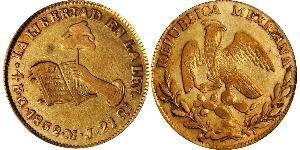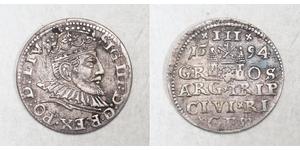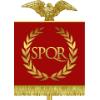8 Реал (продана за $26.0)
1896, Mexico (2nd Republic). Silver 8 Reales (Cap Dollar) Coin. Zacatecas!
Mint Year: 1896 Denomination: 8 Reales Mint Mark: Zs (Zacatecas) Reference: 1896-ZsFZ, KM-377.13. Material: Silver (.903) .7259 oz ASW. Condition: Scattered chopmarks from asian money-changers and bankers, minor glue deposits, cleaned, otherwise VF+ Diameter: 39mm Weight: 26,9gm
Obverse: Phrygian cap with "libertad" inscription, with 32 light rays. Legend: * 8R . Zs . 1896 . F . Z . 10 Ds . 20 Gs .
Reverse: Eagle with a snake in its beak, standing on a cactus plant, sea waves below. Legend: REPUBLICA MEXICANA (terminated by olive and oak branches)
The successful revolt of the Spanish colonies in America, did not stopped the Spanish dollar to dominate the Eastern trade, and the peso of 8 reales continued to be minted in the New World. The coin was sometimes called a Republican dollar, but eventually any peso of the old Spanish 8-real standard was generally referred to as a Mexican dollar, Mexico being the most prolific producer. Mexico restored the standard of 1772, producing a coin of 27.073 g, 0.9028 fine, containing 24.441 g fine silver (the mark weight of the Mexico City mint was very slightly heavier than the standard mark of Spain).
Portuguese merchant ships first arrived on the Chinese coast in 1517. The traders came to buy luxury goods such as silk and porcelain, for which the Chinese favoured payment in silver. As a result, during the eighteenth century European silver coins were exported to China in great quantities, through trade. At one stage almost the only coins used in southern China were European silver coins. Most of this silver was Spanish, much of the metal coming from the Spanish silver mines of the New World. In order to increase trade, the Spanish colonial administration at Manila in the Philippines arranged for silver coin from her American colonies to be shipped directly to Manila. The best known of these coins were the famous 'pieces of eight', the 8 reales piece. Chinese merchants in Manila then carried the silver coin to China where it circulated, mainly in the south-east. The use of silver coins in Chinese trade continued well into the nineteenth century, when silver dollars were often melted into ingots to provide payment as tax. Chopmarks on this 8 reales piece indicate that a Chinese money-changer has tested the quality of the silver. Forgeries were a common problem and cutting into the coin showed whether it was solid silver or just silver coated.
J. Williams (ed.), Money: a history (London, The British Museum Press, 1997)
W. Bertsch, 'Chinese chops - a bibliographical survey of Western publications', Oriental Numismatic Society In, 29 (January 1998)
The First Federal Republic of Mexico (Spanish: Primera República Federal de México) was established on 4 October 1824, after the overthrow of the Mexican Empire of Agustin de Iturbide. In the new constitution, the republic took the name of United Mexican States (Spanish: Estados Unidos Mexicanos), and was defined as a representative federal republic, with Catholicism as the official and unique religion.
However, most of the population largely ignored it. When Guadalupe Victoria was followed in office by Vicente Guerrero, who won the electoral but lost the popular vote, the Conservative Party saw an opportunity to seize control and led a coup under Anastasio Bustamante, who served as president from 1830 to 1832, and again from 1837 to 1841.
This coup set the pattern for Mexican politics during the 19th Century. Many governments rose and fell during a period of instability caused by factors including 1) the control of the economic system by the large landowners, 2) the struggle over the status of Mexico's northern territories, which issued in a devastating defeat at the end of the Mexican–American War; and 3) the gulf in wealth and power between the Spanish-descended elite and the mixed-race majority.
The main political parties during this era were the Conservatives (favoring the Catholic Church, the landowners, and a monarchy) and the Liberals (favoring secular government, the landless majority, and a republic).
Only 1$ shipping for each additional item purchased!

|
Добавил:
anonymous 2017-05-16 |
|
||
|
||
|
||
|
||
1 Талер Бавария (курфюршество) (1623 - 1806) Серебро Максими ...
в группе 31 монет / 29 цен
⇑
3 Грош Польша Серебро Сигизмунд III
в группе 4 монет / 4 цен
⇑

-600-300-Lr0KX9ISRs8AAAFcBH5wgg_Z.jpg)

-300-150-xfzBwcI0kmEAAAEpdtX.2r4Y.jpg)
 Deutsch
Deutsch Русский
Русский Українська
Українська English
English Italiano
Italiano Français
Français Español
Español 汉语
汉语





_(1623_1806)-300-150-EjUKbzbi3qAAAAFN_f9tvwzX.jpg)








